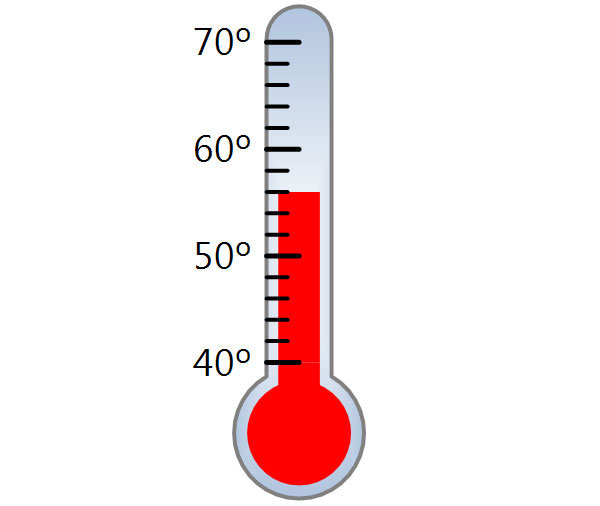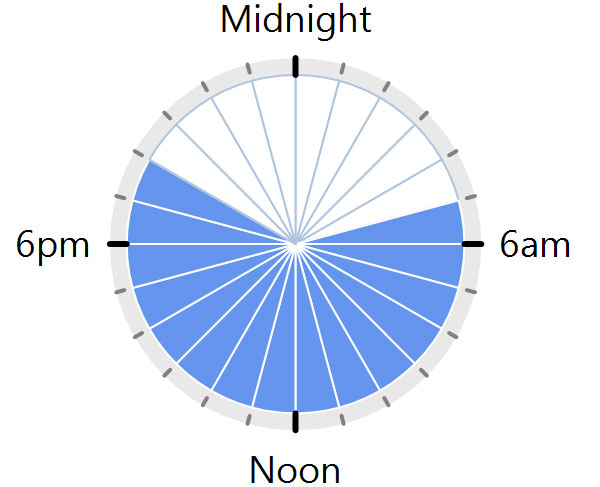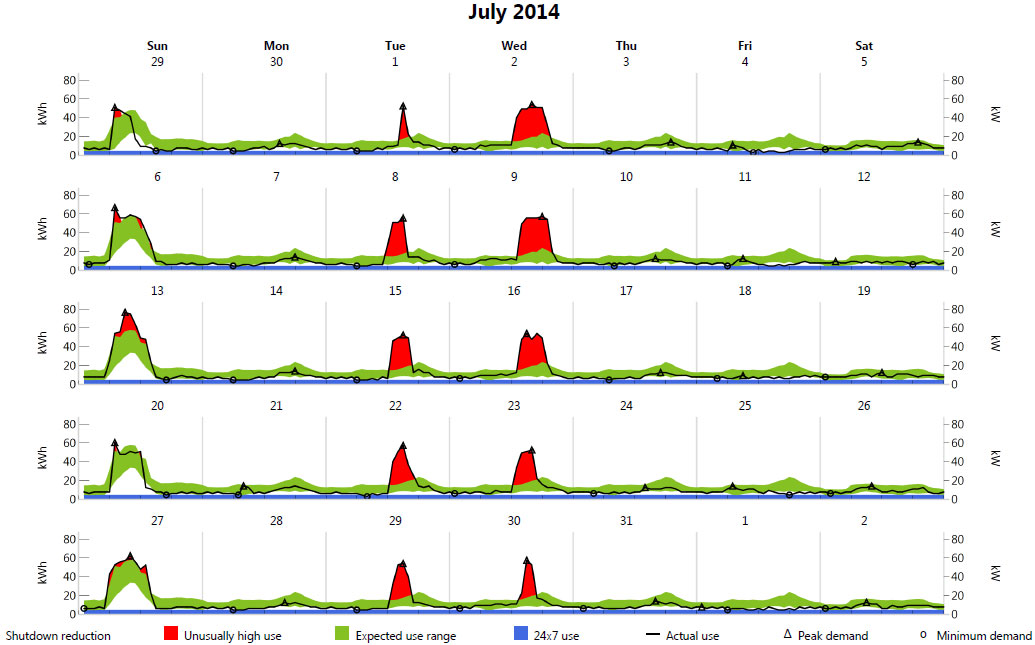Sherlock Holmes, Energy Detective (conclusion)
Updated 12 February 2017
In part 1, Sherlock Holmes received an anonymous letter from the co-owner of an expanding business. The envelope also contained a thumb drive holding a year of electric meter data for the business. The co-owner asked Holmes to analyze the data in an effort to convince the other owner that an energy audit would lead to lower electricity bills. But no other information about the business would be made available to the detective.
Dr. Watson was skeptical that anything useful could be learned solely from meter data. But Holmes quickly identified the dominant energy use patterns, and revealed a potential annual savings of $30,000 from simple operational changes.
Part 1 ends with Holmes cautioning Watson that uncovering additional savings opportunities would require sophisticated techniques of detection.
The trail gets hot (and cold)
"Our next step, Watson, is to determine if our client's electricity use is influenced by weather.
 "Sounds straightforward to me - if electricity use rises in summer, then there must be electric cooling equipment. Or if the establishment is heated with electricity, we should see a rise in winter use." I awaited Holmes' acknowledgement of the wisdom of my approach.
"Sounds straightforward to me - if electricity use rises in summer, then there must be electric cooling equipment. Or if the establishment is heated with electricity, we should see a rise in winter use." I awaited Holmes' acknowledgement of the wisdom of my approach.
"No, I'm afraid that won't do, unless the weather gets hot or cold when the calendar tells it to do so. Besides, we wish to learn if weekdays respond to weather differently than weekends, at what outdoor temperature is heating or cooling required, is the thermostat set back during unoccupied hours..."
"But Holmes," I interjected, "we don't have weather data for the bloody facility, how can you possibly determine these things?
"We assume the approximate location of our client's facility from the postal code on the envelope, a small town in western Massachusetts. By cross-referencing its longitude and latitude with the U.S. National Climatic Data Center list of weather stations, we can download historic weather data from the nearest NCDC station. Here is one within 10 kilometers."
I swore I could smell smoke arising from Holmes' laptop as he furiously tapped away. "Let us apply some basic statistical methods comparing weather to daily and hourly electricity use. Yes, there is a correlation, it appears that about 16% of total electricity use is driven by weather, both warm and cold temperatures."
"So the business requires both heating and cooling?"
 "It would seem so, though heating dominates. Electricity use rises whenever the outdoor average daily temperature drops below 56°F (13.3°C). Using regional electricity prices, we can estimate it costs our client $16 more per day for every °F the daily average falls below 56°F."
"It would seem so, though heating dominates. Electricity use rises whenever the outdoor average daily temperature drops below 56°F (13.3°C). Using regional electricity prices, we can estimate it costs our client $16 more per day for every °F the daily average falls below 56°F."
"Are you saying that on a single day when the average temperature is 46°F (7.8°C), $160 is added to the electric bill?"
"Precisely. An audit can determine if cost-effective measures would improve heating efficiency and bring down that $16 per °F figure. For example, if maintenance is lacking, then a 10% improvement might be expected, which would save almost $5,000 per year."
 "On a positive note, it would appear that our client's thermostat is set back when the business is unoccupied. The blue hours indicate when heating or cooling usually occur. The set back hours are shown in white, from 8pm until 5am, ten setback hours in all each day."
"On a positive note, it would appear that our client's thermostat is set back when the business is unoccupied. The blue hours indicate when heating or cooling usually occur. The set back hours are shown in white, from 8pm until 5am, ten setback hours in all each day."
The expensive music lesson
"Well, Holmes, have you anything else in your investigative bag of tricks?"
"Watson, I never stoop to tricks. I look for energy use patterns, and then for anomalies from those patterns."
"Do you see any more anomalies in this case?"
 "Nothing of significance yet. You remember our engagement letter quotes the partner opinion that 'we run a tight ship here'. In at least one regard, the partner is correct. Their electricity use almost always follows a common pattern, as we saw earlier." (Editor's note: see part 1, "Strange bumps in the night")
"Nothing of significance yet. You remember our engagement letter quotes the partner opinion that 'we run a tight ship here'. In at least one regard, the partner is correct. Their electricity use almost always follows a common pattern, as we saw earlier." (Editor's note: see part 1, "Strange bumps in the night")
"It's quite a contrast to our recent case concerning the Yorkshire church with high electric bills. Do you recall the vicar's reaction when we showed him this chart, Watson?" Holmes opened a document on his computer.
I had to chuckle. "Poor chap turned red as a beet. He had allowed the church organist to practice in the cathedral two afternoons a week. Had no idea it cost the parish £25 for each practice session."
"In my opinion, Watson, a fair price to pay for the comfort of music. Which reminds me, when we are done with this investigation, I must practice my violin. And we are almost finished."
I made a mental note to excuse myself at the appropriate time. Holmes was quite diligent about scraping the strings of his instrument, but "music" it was not.
The dog that didn't bark
"Are you looking for more suspicious spikes in our client's energy use?"
"No, just the opposite in fact. I am looking for entire days when electricity use shut down as much as possible, down to the 24x7 demand leaving only equipment which is always on. Ha, just as I expected! Look here, Watson. This is our client's electricity profile for Christmas week."
"The business appears to be closed on Christmas Day, Holmes, nothing unusual about that, unless our client is Mr. Scrooge."
"Quite right, Watson. And in closing on Christmas Day, they saved about $300 in electricity. You might expect to see this same behavior on other major U.S. holidays, but my examination shows no more of these shutdown days. The electricity load did not fall on Memorial Day, Independence Day, Thanksgiving, etc."
"Perhaps their business does not close on those holidays."
"That is a possibility, but highly unlikely given that their normal weekly energy profile indicates that they are closed on weekends. It would not surprise me if they have some control system which is improperly programmed."
"The typical U.S. commercial enterprise observes 8-10 holidays each year," Holmes continued. "Our client only shut down for one of these. So conservatively, there is a potential annual savings of over $2,000 by ensuring equipment is turned off on holidays."
The trail comes to an end
"Holmes, this has been a most remarkable investigation. Shall I summarize the findings?"
"Please do."
- "First, weekday electricity use rises at 6am and does not drop back down until after 11pm. This likely exceeds weekday occupancy hours. A one hour reduction in this 'on period' would save $7,000 a year."
- "Electricity use on weekends is much lower than weekdays. Yet there is still a small 8 hour bump in load on most Saturdays and Sundays. If this bump is not essential to operations, its elimination would save $6,000 a year."
- "Almost 40% of total electricity use is from equipment which is always on, 24x7. If this demand can be reduced by 10%, it would lower the electric bill by $17,000 each year."
- "About 16% of total electricity use is driven by weather. Heating and cooling primarily occur during occupied hours, indicating good use of thermostat set back. If overall system efficiency can be improved by 10%, the annual savings would be $5,000."
- "Finally, electricity use does not shut down for most major holidays. If the business is in fact closed on these days, then an additional annual savings of $2,000 or more would result from ensuring that equipment is also on holiday."
"Let's see, it all adds up to a potential savings of $37,000 per year. That should get the partner's attention."
"I would expect so, Watson. And that is our charge from the client - demonstrate that their business is not behaving as expected, at least from the perspective of their electric meter. And while these analyses are built upon assumptions that only an on-site audit can verify, the partner should now be convinced that such an audit will reap significant rewards."
"And to think, Holmes, that you came to these findings with only the meter data at your disposal."
"Elementary, my dear Watson." With that, Holmes reached for his violin and bow.
"If you will excuse me, Holmes, I had better write this up for our client while it is still fresh in my mind"
Click here to read part 1. Energy professionals, if you would like to find out more about Sherlock Holmes' analytics, including how to incorporate them into your toolkit of services, click here.
© Copyright 2025 ENERGYai®









